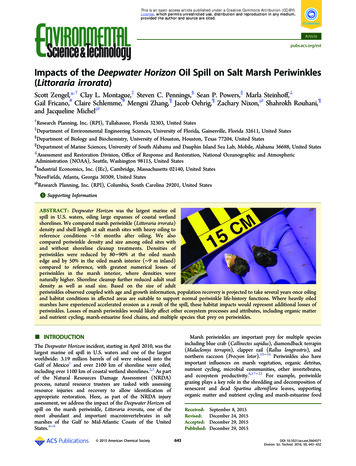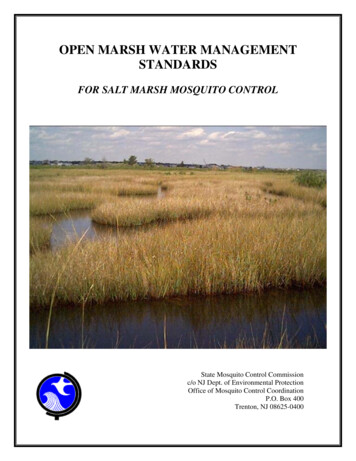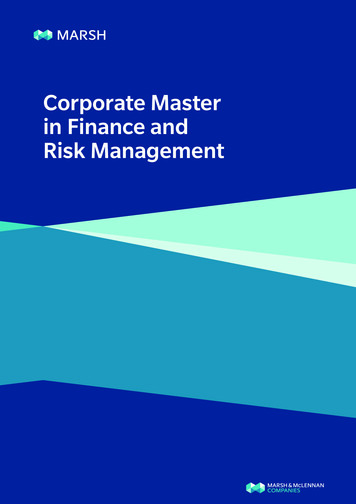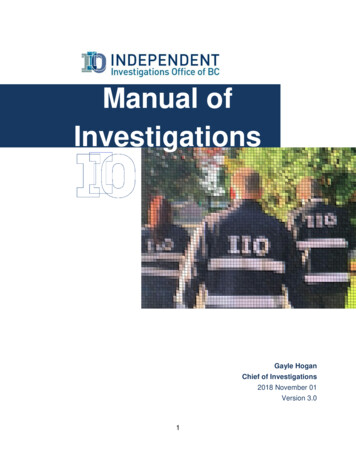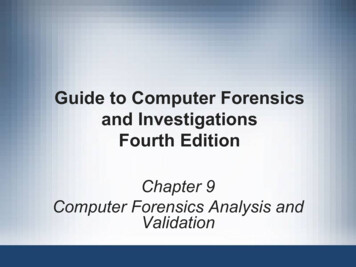
Transcription
ACADEMY OF RISKINVESTIGATIONSAND THE OUTCOMESMANAGING THE CRISISWITH A D&O POLICY
CONTENTSP1P2P4P62INTRODUCTIONTHE STRUCTURE OF A D&O POLICYCOVER FOR INVESTIGATIONSTHE AFTERMATH OF AN INVESTIGATION:WILL YOUR POLICY RESPOND?P8KEY POLICY EXCLUSIONS: HOW DOESTHIS AFFECT THE OUTCOME?P10P12IMPORTANCE OF NOTIFICATIONCONCLUSION
INTRODUCTIONRegulatory investigations are serious matters that can result in potentiallysevere outcomes for companies and their directors and officers.For directors and officers, it is of great concern that the consequences of aregulatory breach can potentially include criminal prosecution, various finesand penalties, litigation, significant legal costs and expenses, anddisqualification or imprisonment.A regular stream of well-publicised cases in this area also serves as a starkreminder that regulators have become increasingly aggressive in their pursuitof investigations and prosecutions not only against companies but also theirdirectors, officers and employees.In this context, the following paper examines how directors and officers (D&O)liability insurance can help to reduce and contain the cost and impact of aregulatory investigation, and protect a company’s bottom line as well asnon-financial loss. Regulatory investigations can be complex and protractedprocesses, with the outcomes often presenting even greater challenges.By thoroughly understanding the coverage available in a D&O policy, andhow to best preserve and protect the coverage, directors and officers willbe better equipped to navigate the minefield of an investigation, shouldthey be faced with the task.1
THE STRUCTUREOF A D&O POLICYThe following diagram illustrates the basic structure and operation of a D&O policy.D&O POLICY COVERAGE STRUCTURECovered Claim AgainstDirectors and OfficersYesCovered Claim AgainstCorporate EntitySIDE ASIDE BSIDE CInsuredsDirectors and OfficersInsuredsCorporate Balance SheetInsuredsCorporate Entity(Securities Claims Only)Personal AssetsCorporate AssetsCorporate AssetsD&O InsuranceInsuring Agreement A:Individual InsuredsD&O InsuranceInsuring Agreement B:Corporate Reimbursementof Individual InsuredsD&O InsuranceInsuring Agreement C:Corporate Entity Coverage(Securities Claims Only)Personal Assets ProtectionCorporate Risk TransferCorporate Risk TransferNoIndemnificationPersonal AssetProtection(Individual)2BothCorporate RiskTransfer(Company)Traditionally, directors and officers(D&O) liability insurance containedtwo separate insuring clauses. Thefirst clause (popularly referred to asSide A cover), pays on behalf of theindividual directors and officers forlosses that are not indemnified bythe company. The second insuringclause (known as Side B cover),reimburses the company for paymentsit makes to indemnify its directors andofficers. Both sides of cover apply onlyto loss incurred by the directors andofficers in claims against them fortheir own wrongful acts. Neither sideof cover insures a company for lossesit incurs as a result of claims againstthe company.Many D&O policies now include athird insuring clause (also knownas Side C cover), which insures lossincurred by the company, resultingfrom its own wrongful acts. Thiscoverage typically applies only to‘securities claims’, and providescover to companies for their liabilityin claims made against them inrelation to their securities.
The majority of claims fall under thecompany reimbursement clause(Side B), reflecting the commonpractice shared by most companiesin providing their directors andofficers with some form of indemnity.These indemnities can be provided bya company in its constitution and/orby a Deed of Indemnity provided toindividual directors. There are,however, certain claims for which itis unlawful for a company to indemnifya director.The coverage provided directly todirectors and officers (Side A cover)is triggered, depending upon thepolicy wording, when directors andofficers are not, or cannot be,indemnified for claims against themin their capacity as such.There are essentially two situationsin which a Side A insuring agreementwould typically respond:1234 Where the company has a poweror an obligation to indemnify oneof its directors and officers, but iseither unwilling or unable to doso e.g. a cash flow restraint or ifthe company became insolventor was in bankruptcy. Where the company is prohibited1by law from indemnifying itsdirectors and officers e.g. Section199A of the Corporations Act2001(Cth)2 prohibits a companyfrom indemnifying its directorsand officers for various liabilities.Any policy that purports to indemnifya person against a liability in breachof section 199A is void3.It is critical therefore that a D&Opolicy (to the greatest extent possible)provides cover for liabilities wherethe company cannot indemnify itsdirectors and officers as a matter oflaw, otherwise there will be no coverat all and the personal assets ofdirectors and officers may be exposed4.See also prohibitions under section 229 of the Australian Consumer Law (ACL) and section 77A of the Competition and ConsumerAct 2010 (Cth) (CCA). In 2010 the Trade Practices Act 1974 (Cth) was renamed the CCA. The ACL is included as a schedule to theCCA (now schedule 2).Applies to all companies whether public or proprietary and whether commercial or non-profit. See Austin, Ford, Ramsay, CompanyDirectors - Principles of Law & Corporate Governance at page 653 LexisNexis Butterworth’s Australia 2005Section 199C(2) Corporations Act 2001 (Cth)Emilios Kyrou, Partner, Mallesons Stephen Jaques, ’ Does the Directors & Officers Policy cover your Risks? – A Gap analysis of CompanyIndemnity versus the D&O Insurance Policy’. Paper delivered at the Directors and Officers Liability and Insurance Symposium, Sydney29 August 20063
COVER FORINVESTIGATIONSCoverage offeredunder D&O policiescan vary significantlyacross differentinsurer offerings,particularly aroundcover forinvestigationsand the associatedfinancial loss.Specific cover for investigations isa recent but rapid evolution and isnow considered a critical componentin a D&O policy. Whether and towhat extent cover will be providedwill often depend on the specificnature and type of investigationand the actual language of thepolicy. The analysis is often veryfact intensive and as no twoinvestigations will be the same,neither will the policy response.Most D&O policies now expresslyprovide some form of cover for legalrepresentation expenses incurred asa result of an investigation.Cover is typically triggered whena director or officer5 is identified inwriting6 by the body instigating theinvestigation.An investigation is typically definedin a D&O policy as “a formaladministrative or formal regulatoryinquiry or examination by a regulatory,self-regulatory, governmental,professional, trade, statutory orofficial body or institution, including,a royal commission, commission ofinquiry, judicial body or stockexchange that is empowered by lawto investigate the affairs of an insuredperson in his insured capacity, ora company or to conduct a raid”.4Legal representation expenses aretypically defined as “reasonabledefence costs which an insuredperson incurs on account of theattendance and/or the provisionof documents or information at orto any investigation or on account ofthe preparation for such attendanceor provision, which attendance and/or provision is required by the bodyinstituting the investigation”.To be provided with the broadestprotection in the event of aninvestigation, this cover should: Not be sub-limited. A full policylimit should always apply. Apply even when a wrongful acthas not been alleged. This can beimportant in relation to investigations,as at least at preliminary stages,these can be more of an evidencegathering exercise. Extend to an employee of acompany when the employeeis involved in an investigation7.Retired D&O should also havethe benefit of this cover8. Contain an advance paymentpromise such that costs will bepaid prior to final disposition ofthe investigation and within a shortperiod of receipt of an invoice9.
Additionally, it is important tonote that cover: Does not extend to costs thecompany may incur in its ownname and on its own behalf. Does not typically extend toinformal or internal investigationsor voluntary compliance with aregulator’s oral requests (althoughwordings are rapidly evolving inthis regard as discussed below). Is often subject to the insuredobtaining the insurer’s consentto their nominated defencelawyers. This consent inpractice extends to the hourlyrate proposed to be chargedby the insured’s nominatedlawyers; since a typical D&Opolicy only requires insurer’sto pay ‘reasonable10’ fees,costs and expenses.PRE-INVESTIGATIVE COSTSThe better D&O polices now includesome form of cover for costs incurredby or on behalf of directors andofficers in: Preparing any formal notificationto any regulator or official body ofany actual or suspected materialbreach of a company’s legal duty. Conducting any internalinvestigations 11 where requestedby the regulator or official bodyfollowing a company’s formalnotification.Cover can be sub-limited and additionalpremium and conditions may apply.Although limited cover is available,insurers have generally taken the viewthat internal investigations should beregarded as a business expenseconsistent with good corporategovernance practices, and not operateto erode coverage under a D&O policy.5678Or other individuals identified in the definition of Insured PersonCosts incurred pre- investigation and for example in self reporting breaches are unlikely therefore to be covered.Refer to the definition of “Insured Person”.Refer to the definition of Insured Person in your D&O policy which should include any natural person who was, is or shall be adirector or officer of the insured organisation.9 Note: Costs advanced typically must be repaid by D&O severally and according to their respective interests, if and to the extent itis determined that such costs are not insured under the D&O Policy.10 Some policies also include a “necessary” test.11 For example costs incurred in appearing at or pre-paring for a meeting or interview or in producing documentary or electronicinformation.5
THE AFTERMATH OF ANINVESTIGATION: WILL YOURPOLICY RESPOND?PROSECUTIONS ANDASSOCIATED COSTSIf a prosecution is commenced bya regulator against a director orofficer, this should trigger thedefinition of a ‘claim’ (including acriminal proceeding) under atypical D&O policy.As a result, directors and officersshould be covered for amounts12they become legally liable for indefending such a prosecution.The better D&O policies shouldprovide that defence costs will beadvanced for or on behalf of thedirector or officer prior to the finaldisposition of any prosecution andwithin a short period (typically 30days) of receipt of the invoices forsuch defence costs.Typically, cover for prosecutionsagainst a company itself is notexpressly covered13 and is unlikelyto trigger the definition of claim ina D&O policy, even where Side Ccover has been purchased.CIVIL PENALTY PROCEEDINGS,FINES AND PENALTIES, ANDDISQUALIFICATION ORDERSThe definition of ‘claim’ in most D&Opolices includes, among others, any‘civil proceedings’ and, consequently,cover should be available for any civilpenalty proceedings that may beinstigated by a regulator for statutorybreaches following an investigation.D&O policies will typically providecover for civil fines and pecuniarypenalties unless the insurer is legallyprohibited from paying such fines orpenalties in the jurisdiction where theclaim is determined. In some D&Opolicies, sub-limits and jurisdictionallimitations may apply. Given that acompany cannot indemnify itsdirectors and officers for civil penaltiesunder the Corporations Act andCompetition and Consumer Act 2010(Cth) to name a few and regulators areincreasingly using civil penaltyproceedings as a key enforcementmechanism, this is a criticallyimportant aspect of cover.Currently in Australia, there isuncertainty as to whether insurancecover can extend to criminal finesand penalties.6However it is important to keep inmind that most D&O policies excludematters uninsurable at law.14 This is forreasons of public policy on the basisthat a person may not benefit fromhis/her own wrongdoing and, byextension, may not be indemnifiedagainst the consequences of thatwrongdoing. Any insurance contractpurporting to insure against such riskswould be void and unenforceable.This would include any policy thatpurports to indemnify a personagainst criminal liability if the crimeis committed with guilty intent.The position is less clear where thecrime is one of strict liability and theconduct of the offender is morallyinnocent, although the majority ofcommentators prefer the view thatan indemnity ought to, and can begiven. It may depend on whetherthere is an element of fault or intentattributable to the person who hascommitted the strict liability offence.It might be argued that the term‘pecuniary penalty’ in a D&O policy isbroad enough to encompass insurablecriminal penalties. In this respect apecuniary penalty would be viewedmerely meaning a monetary penalty.
Importantly, D&O policies do notcover fines and penalties assessedagainst the company itself.In addition to cover for legal costsand expenses incurred in defendingdisqualification orders, most D&Opolicies will also cover: Reasonable legal costs incurredby an insured person to bringlegal proceedings (as distinctfrom defending proceedings) tooverturn orders disqualifying adirector or officer from managinga corporation. This is an importantaspect of cover given the seriousconsequences that followdisqualification as a companydirector.Reasonable costs and chargesin hiring a public relations firmto mitigate the effects of any“published negative statements”arising from an investigation andflow on litigation;The cost of associated appeals.CIVIL LAWSUITSFollow-on civil lawsuits can take manyforms while potential claimants andallegations are numerous.All D&O policies essentially coverdirectors and officers for claimsalleging wrongful acts and generallyencompass ‘any civil proceedings’.Further, the definition of wrongful actsis usually broadly defined and typicallyincludes ’any actual or alleged breachof duty, breach of trust, neglect, error,misstatement, misleading statement,omission, breach of warranty ofauthority or other act done or wronglyattempted by a director or officer intheir capacity as such’. On this basis,a D&O policy should respond tofollow-on litigation15.D&O policies that afford entitycoverage for securities claims (i.eSide C cover) will typically includea definition of ‘securities claims’ oralternate definition of ‘wrongful act’.The scope of these definitions canvary significantly between policyforms. Some definitions are ratherlimited, applying only to claimsinvolving the purchase or sale ofsecurities issued by the insuredcompany. Other definitions arebroader, extending beyond claimsfor alleged violation of any federal orstate securities law to include claimsfor violation of common law or, indeed,any claim brought or maintained by oron behalf of securities holders of theinsured company.Notably, some D&O policies also coveremployees named as defendants in afollow-on law suit for the time that theemployee is the subject of a claim,along with any director or officer orwhere such employee is acting in amanagerial or supervisory capacity.As a result, directors and officers(or the company in the event of asecurities claim) should be coveredfor any ‘loss’16 they become legallyliable for in defending, investigating,settling or appealing claims that oftenarise following an investigation.Loss is typically defined to includedamages (including compensationorders), judgments (including preand post interest), settlements(entered into with the insurer’sconsent) and defence costs andother associated expenses such asclaimant’s costs and crisis costs.14 Refer to the definition of “Loss” as amended by endorsement15 Subject always to any exclusions, conditions and jurisdictional limitations.16 Usually detailed in the definition of “Loss”. Note exclusionary language often appears.7
KEY POLICY EXCLUSIONS:HOW DOES THIS AFFECTTHE OUTCOME?In all D&O policies,coverage forinvestigationsand any follow onlitigation will becompromised byany policy exclusionscontained.8Most D&O policies exclude thefollowing classes (or components)of claim: Bodily injury/property damage –D&O insurance is a protectionagainst financial liabilities anddoes not extend to cover directliabilities for personal injury.Claims arising from bodily injuryor property damage are typicallycovered under other policies suchas general liability policies. Thebodily injury exclusion in the betterD&O policies does not apply tooccupational health and safetydefence /investigation costs, ormental anguish or emotionaldistress in connection with an‘employment claim’. Pollution – Pollution exposuresare typically covered undergeneral liability or environmentalliability policies. Notwithstandingthis exclusion, most D&O policieswill offer limited cover for certainenvironmental claims. Clean-upcosts are, however, generallyexcluded.
Prior known matters, suits orproceedings – Such matters shouldhave been notified in the period inwhich the claim, or circumstancesgiving rise to a claim, arose. Somerelief may be available in D&Opolicies that contain a ‘continuityof cover’ extension. Professional services – D&Oinsurers do not intend to cover acts,errors or omissions committed byan insured in the performance (ornon-performance) of professionalservices. Such exposures aretypically covered underprofessional indemnity policies. Insured v Insured claims – MostD&O policies contain this exclusion,which was developed to avoid thesituation of companies bringinglawsuits against their directors inorder to trigger a claim (andpayment) under the D&O policy.This exclusion may adverselyimpact a shareholders derivativelawsuit unless one of theexceptions can be seen to apply17.The better D&O policies onlyexclude USA-related insured versusinsured claims, subject to certainwrite backs. Fraud and dishonesty – No D&Opolicy will provide cover to aninsured person for his or her owncriminal, dishonest or fraudulentacts or omissions. Any profit oradvantage gained by an insuredperson to which he or she has nolegal entitlement is also generallyexcluded. To the extent providedfor by the severability and nonimputation provisions, innocentinsureds will be entitled to cover.In the better D&O policies, thisexclusion does not apply todefence costs or other expensesadvanced under the D&O policyuntil a final, non-appealableadjudication in any proceedingestablishes the excluded conduct;in which case any costs advancedwill need to be repaid. Matters uninsurable at law – Thisexclusion can extend to any coverthat the policy may provide forfines and penalties. Notably, someD&O policies specifically excludecover for any fines and penalties.17 The exclusion does contain a ‘whistleblower and non collusion exception’ as well as for Defence Costs and other expenses.9
IMPORTANCE OFNOTIFICATIOND&O policies areissued on a ‘claimsmade’ basis, whichmeans thatthe policy coversclaims, includinginvestigations,made during thepolicy period andreported duringthe policy period(or the extendedreporting /discoveryperiod if that optionis purchased).Claims made policies do not requirethe incident resulting in a claimto have taken place within the policyperiod.The better D&O policies also expresslyprovide for the notification ofcircumstances likely to give rise toa claim and, consequently, providecover for claims made outside thepolicy period if notification took placewithin the policy period.Even where a D&O policy does notexplicitly provide for the notificationof circumstances likely to give rise toa claim, policyholders have a statutoryright18 to notify insurers of anypotential claim. Any notification of apotential claim must be made as soonas reasonably practicable and beforethe end of the policy period.While investigations and follow onlitigation can move quickly and oftendeal with commercially sensitive andconfidential information, it isimportant that companies pay closeattention to the definition of a claim,and follow the notification and claimshandling conditions as set out in thepolicy so as to not prejudice coverwhen it is most needed.Problems can arise when a company,director or officer fails to notifyinsurers at the point it first receivesnotice of a charge or complaint ofpotential contraventions, instead onlyreporting the matter when a lawsuit isfiled. This is even more critical if thecharge or complaint was made priorto the inception of the policy19.Consider that many a class actionlawsuit started with a singleindividual’s complaint.18 by virtue of section 40 of the Insurance Contracts Act 1984 (Cth).19 All D&O policies contain Prior Notice and Prior Litigation exclusions.10
The late notification of claims orcircumstances creates unnecessarydifficulties between the insuredand the insurers. While there is stillpotential for cover to be providedin certain circumstances, it is notguaranteed, with late notificationdisputes often requiring a courtadjudicated outcome. To avoid thesecomplications, always notify anyclaims or circumstances promptlyand during the policy period.It is therefore important thatcompanies and their directorsand officers: are aware of the period of cover; review all claims and ‘potentialclaims’; notify immediately anycircumstances (i.e. complaints)likely to give rise to a claim orinvestigation during the policyperiod, so as to not prejudice thebenefit of cover under the policyfor any subsequent claim that mayarise. All claims should be notifiedon receipt; do not make any admissions orengage in settlement discussionswhich may prejudice your insurer’ssubrogation rights; always seekinsurer’s consent for strategy andsettlement; follow the policy’s noticerequirements. Each insurer’sclaim reporting requirementsoften differ by varying degrees; retain appropriate experts earlyand always with the insurer’sconsent; keep a record of all notificationsmade to insurers and keep insurersinformed of developments at all times.11
CONCLUSIONBeing the subject of an investigation is a serious matter and not just for thecompany. Directors and officers can personally face significant fines anddisqualification periods. Further, both the company and its directors andofficers can be the subject of protracted and costly follow on litigation andunavoidable damage to reputation.As investigations by regulators often result in adverse findings and give riseto civil or criminal proceedings against directors and officers20, assurances thatdirectors and officers are covered for legal representation, defence costs andthe payment of fines and penalties is critical.Against the current climate, where both regulatory investigations and civilaction have become more aggressively pursued, it is important for directorsand officers to be confident that the D&O policy is structured to provide themwith the broadest cover possible.20 Refer to Emilios Kyrou article in footnote 4.12
13
marsh.com.auNEXT STEPSFor more information about how you canbenefit from our services, please contactyour Marsh Adviser or call:1800 194 888About Marsh: Marsh, a global leader in insurance broking and risk management, teams with its clients to define, design, and deliver innovativeindustry-specific solutions that help them protect their future and thrive. It has approximately 26,000 colleagues who collaborate to provide adviceand transactional capabilities to clients in over 100 countries. Marsh is a wholly owned subsidiary of Marsh & McLennan Companies (NYSE: MMC),a global team of professional services companies offering clients advice and solutions in the areas of risk, strategy, and human capital. With 53,000employees worldwide and annual revenue exceeding 11 billion, Marsh & McLennan Companies is also the parent company of Guy Carpenter,a global leader in providing risk and reinsurance intermediary services; Mercer, a global leader in human resource consulting and related services;and Oliver Wyman, a global leader in management consulting.Disclaimer: This is a general overview of the insurance cover. Please call us and ask for a copy of the insurer’s policy wording. We recommend you readthe policy wording so you have an understanding of the policy terms, conditions and exclusions before you decide whether a policy suits your needs.This document is not intended to be taken as advice regarding any individual situation and should not be relied upon as such. Marsh shall have noobligation to update this publication and shall have no liability to you or any other party arising out of this publication or any matter contained herein.Any statements concerning legal matters are based solely on our experience as insurance brokers and risk consultants and are not to be relied upon aslegal advice, for which you should consult your own professional advisors. Marsh Pty Ltd (ABN 86 004 651 512, AFSL 238983) arranges the insuranceand is not the insurer. Copyright 2014 Marsh Pty Ltd All rights reserved.
Indemnity versus the D&O Insurance Policy'. Paper delivered at the Directors and Officers Liability and Insurance Symposium, Sydney 29 August 2006 Where the company has a power or an obligation to indemnify one of its directors and officers, but is either unwilling or unable to do so e.g. a cash flow restraint or if



